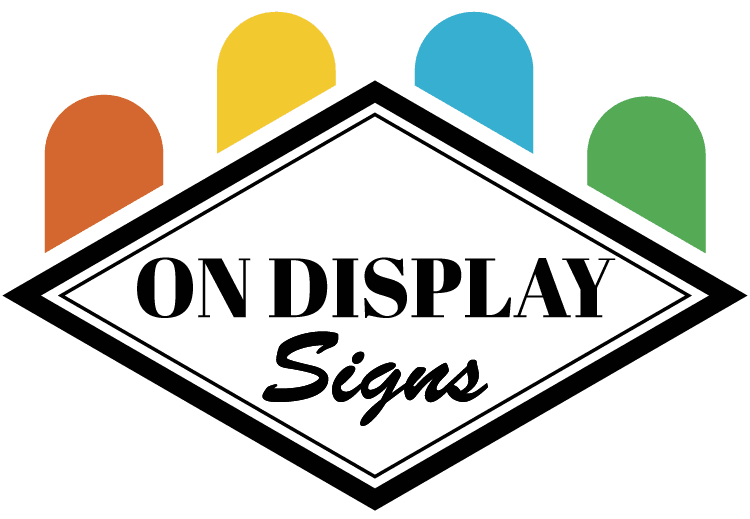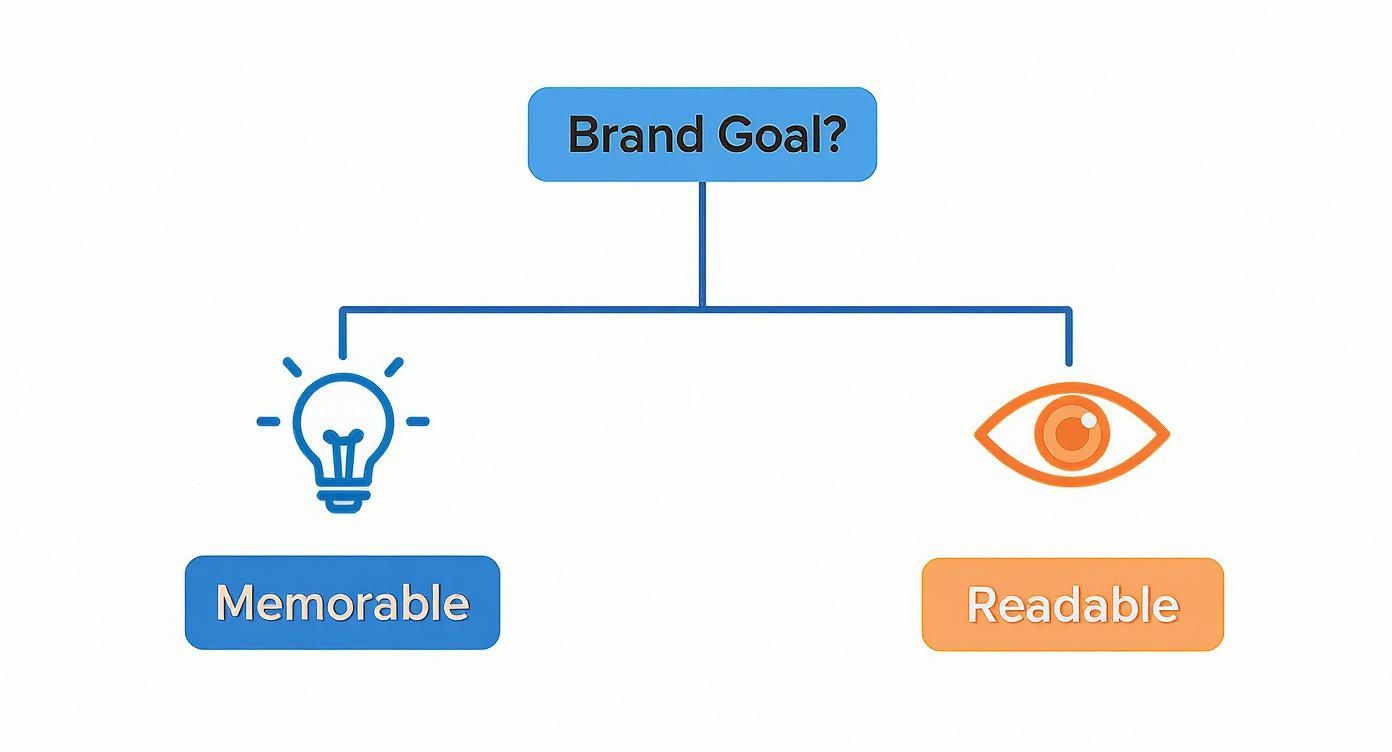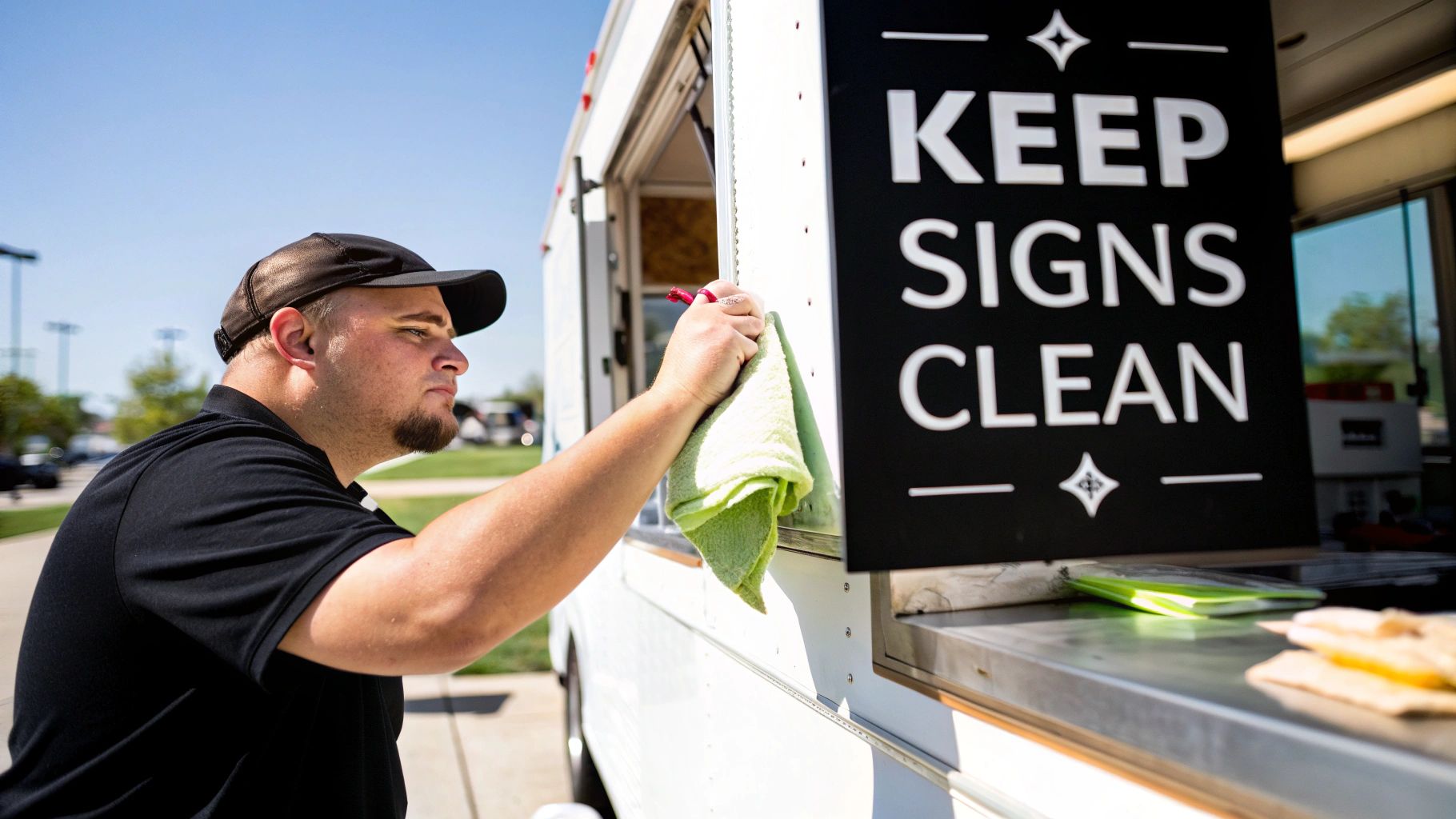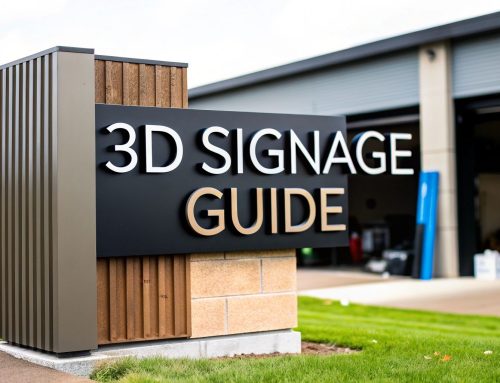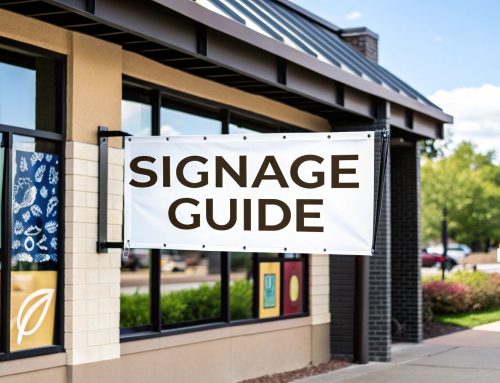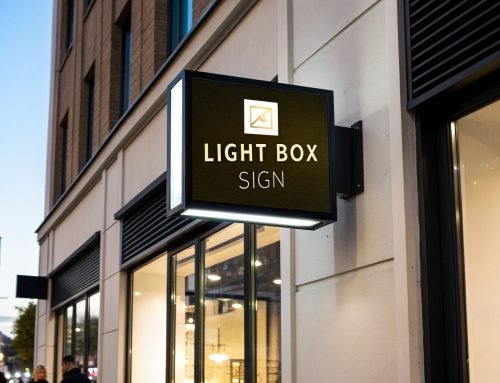Your food truck signage is your 24/7 salesperson. It works tirelessly to grab attention, tell your brand's story, and pull in customers before they've even had a chance to smell what's cooking. Think of it as the first handshake—the visual hook that convinces a curious passerby to stop and become a loyal customer.
Why Your Signage Is Your Most Valuable Employee
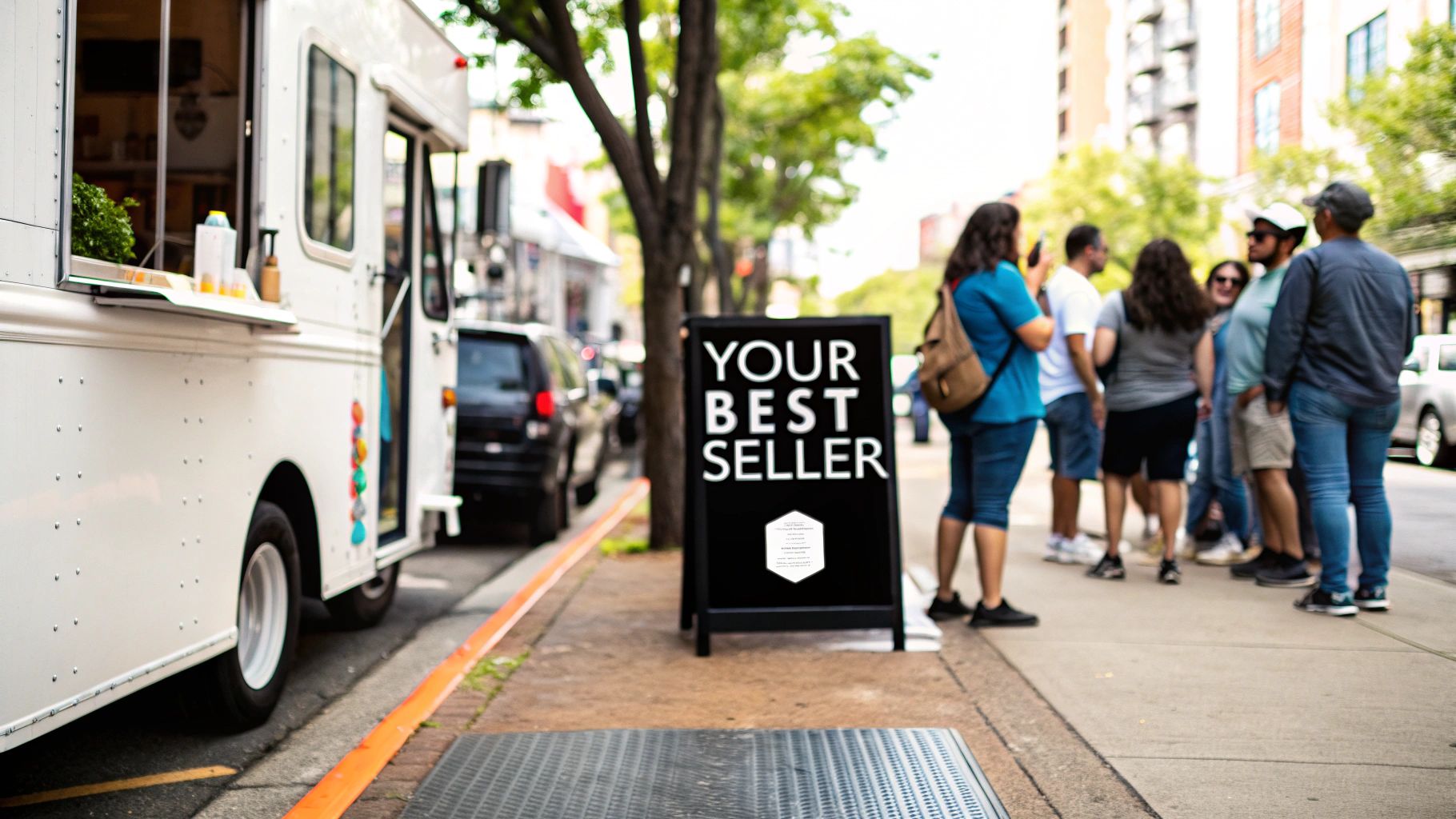
Before anyone gets a whiff of your sizzling food or a glance at your menu, they see your truck. In a crowded festival or on a busy city block, your signage has to do all the heavy lifting. It's not just decoration; it's a hard-working marketing tool that builds your business from the ground up.
A potential customer gives you just a few seconds of their attention. In that tiny window, your signage needs to answer some big questions. What kind of food do you serve? What's your vibe—fun and quirky, or clean and gourmet? Great signage communicates all that in a single glance.
The Power of a First Impression
In the food truck game, visual appeal directly translates to foot traffic. A truck with sharp, professional, and inviting signage feels more trustworthy and hints at a higher-quality product. On the flip side, a truck with faded, confusing, or cheap-looking signs can be a major turn-off. People might just assume the food is as neglected as the exterior. Your signage sets the expectation.
Here are the actionable jobs your "signage employee" is doing for you:
- Attraction: It snags eyeballs from across a park or down the street. For example, a bright yellow sign on a hot dog truck will stand out in a green park.
- Information: It tells people exactly what you sell, making their decision to stop quick and easy. A sign that clearly says "Gourmet Burgers & Fries" leaves no room for confusion.
- Branding: It creates a memorable identity that helps customers find you again and tell their friends about you. A unique logo and consistent color scheme make you recognizable.
Turning Visuals into Profit
This isn't just theory; it has a real impact on your bottom line. Initial branding—which includes your logo design and the actual signage—can run anywhere from $3,300 to $7,500 for a food truck just starting out. That’s a serious chunk of change, which proves this is a foundational business asset, not just a finishing touch.
Practical Example: Imagine a food truck parked at a festival, surrounded by dozens of other options. A simple, generic "Tacos" banner gets lost in the noise. But a sign with a unique logo, bold colors, and a killer name like "The Tortilla Tornado" creates a brand that people actually remember.
Ultimately, your signage is a critical investment. It works around the clock to define who you are and draw the crowds you need for a profitable day. If you're looking for inspiration, it's worth exploring some creative business sign ideas to spark the perfect concept for your truck. The right visual strategy doesn't just decorate your vehicle; it actively builds your business.
Designing Signs That Capture Attention and Appetites
Okay, let's get into the fun part: turning your truck into a customer magnet. Great food truck signage is a mix of art and street smarts. It's the first handshake with a potential customer, and it needs to be a good one, converting a curious glance into a committed order in just a few seconds.
Your design isn't just about looking cool; it’s about answering three questions instantly: Who are you? What do you sell? And what's the vibe? A sign that's cluttered or hard to read is a sign that gets ignored. People will just walk on by. A clean, bold design, on the other hand, pulls them in and builds immediate trust.
The Foundation of Readability and Recognition
Here's the single most important rule: your sign must be readable from a distance. Someone standing across the street or at the other end of a packed festival needs to know what you're about. This is where your font and color choices become your best friends.
Actionable Insight: Before finalizing your design, print out a small version of it. Step back 10-15 feet. Can you still read the most important information, like your business name and what you sell? If not, increase the font size or choose a bolder typeface.
Imagine a truck selling fancy grilled cheese sandwiches. Using a delicate, swirly script font might feel upscale, but from 50 feet away, it’s just a blur. A much better choice is a thick, clean sans-serif font like Helvetica Bold or Franklin Gothic that stays sharp and legible, even at a quick glance. The real goal here is to remove all the guesswork. A customer should never have to squint or wonder what you sell.
Picking the right typography is a big deal for any sign. When you need lettering that works on various materials, you can dive deeper into choosing the best fonts for metal signs to make sure your brand and menu are always on point.
Crafting an Unforgettable Visual Identity
Beyond pure legibility, all your design elements need to work together to tell a single, cohesive story. This visual language should be consistent across every part of your truck, from the main sign down to the menu board.
- Logo Design: Keep it simple. Your logo has to look great blown up on the truck and shrunk down on an Instagram profile picture. Example: a truck called "The Rolling Pin" using a stylized rolling pin icon—it’s clean, scalable, and tells you exactly what they do.
- Color Palette: Stick to two or three high-contrast colors. Example: a taco truck might go with a vibrant yellow and teal to scream "fun and festive." A coffee truck, meanwhile, could use warm browns and cream to create a cozy, approachable feeling.
- Imagery: If you're using photos, they better be amazing. A single, high-quality, drool-worthy picture of your signature burger will do more work than a collage of ten mediocre shots. The photo should make people hungry just by looking at it.
These elements are your brand's DNA. They create a consistent look that helps people remember you, find you in a crowd, and come back for more.
Key Design Elements for Effective Signage
| Design Element | Best Practices | Common Mistake to Avoid |
|---|---|---|
| Typography | Choose 1-2 bold, clear fonts that are legible from at least 30-50 feet away. | Using more than three different fonts, or choosing styles that are too thin or overly decorative. |
| Color Scheme | Select 2-3 high-contrast colors that reflect your brand's personality and stand out in various lighting conditions. | Picking low-contrast colors (like light grey on white) that wash out in bright sunlight or at night. |
| Logo | Keep it simple, memorable, and scalable. The design should hint at your cuisine without being overly complex. | Creating a logo that is too detailed to be recognized quickly or from a distance. |
| Layout & Spacing | Use plenty of negative space to avoid a cluttered look. Group related items together on your menu logically. | Cramming too much information into a small space, making the entire sign overwhelming and unreadable. |
Getting these core elements right from the start is what separates the trucks with long lines from the ones people just walk past. It’s your visual promise of the delicious food to come.
Choosing the Right Materials for Your Signs
The materials you pick for your food truck signs are just as critical as the design itself. This choice dictates how long your signs will last, how they’ll hold up after a season of sun and rain, and how much work they'll be to maintain. Getting the material right is a smart investment that keeps your truck looking professional and inviting.
This goes way beyond just aesthetics; it's a practical, day-in-the-life decision. A heavy, solid wood sign might have a great rustic vibe, but it's a nightmare to haul out and set up every single morning. On the flip side, a cheap, flimsy banner might be light, but it will tatter in the first strong wind, making your whole operation look amateur. The sweet spot is finding a balance between durability, cost, and visual punch.
This decision tree can help you zero in on the right goal for your brand.
This visual boils it down to a fundamental choice: are you building a memorable brand or just need immediate readability? Both are crucial for effective food truck marketing, but they often require different materials.
Durable Materials for Core Branding
For the main signs on your truck—the ones that shout your logo and business name—durability is everything. These signs are constantly battered by the elements, from intense sunlight that fades colors to road grime and heavy rain.
Aluminum composite material (ACM) is a top-tier choice for this job. It’s made of a solid plastic core sandwiched between two thin sheets of aluminum, making it both lightweight and incredibly tough. It won’t rust like raw steel or warp like wood, and it gives you a perfectly smooth canvas for crisp, clean graphics. To get a better feel for this option, you can learn more about the benefits of aluminium composite signage.
Another workhorse is high-quality outdoor vinyl. I’m not talking about the flimsy stuff you see on temporary banners. Professional-grade vinyl is built to resist weather and can be applied directly to your truck’s surface. It delivers vibrant colors and can be cut into intricate shapes for logos and lettering.
Flexible Options for Menus and Specials
Your menu board has to be a chameleon—tough but adaptable. Prices shift, ingredients run out, and daily specials need to be front and center. Materials that let you make quick updates are absolutely essential for running a smooth service.
- Chalkboard Signs: A classic for a reason. Chalkboards give off a rustic, hands-on vibe that customers love and are perfect for daily changes. The big downside? Rain is their mortal enemy, and chalk can get messy or become hard to read if your handwriting isn't sharp.
- Whiteboard Signs: This is the more modern take on the chalkboard. Whiteboards offer a cleaner look and are generally easier to read from a few feet away. Just be sure to use high-quality dry-erase markers to avoid that annoying "ghosting" stain. Both chalkboards and whiteboards need to be brought inside or protected when the weather turns.
Actionable Insight: Go for a hybrid approach. Get your main menu categories and item names permanently printed on a durable board, but leave blank spaces next to them for the prices. You can use small, easy-to-change inserts or even simple vinyl decals for the pricing. This gives you the best of both worlds—permanence and flexibility.
Portable Signs for Maximum Visibility
Don’t forget the signs that aren’t attached to your truck. Portable signs are your secret weapon for pulling in foot traffic from down the block or across a crowded field. These signs have to be light enough to carry and set up in a flash but sturdy enough not to blow away in a stiff breeze.
Here’s a quick breakdown of the most common portable sign materials:
| Sign Type | Primary Material | Best For | Key Consideration |
|---|---|---|---|
| A-Frame Signs | Wood, Plastic, or Metal | Sidewalks, event entrances, guiding queues. | Weight is a big deal. A heavier base is your best friend for preventing tipping in the wind. |
| Feather Flags | Polyester Fabric, Fiberglass Pole | Crowded festivals, grabbing attention from far away. | Make sure the fabric is weather-resistant and the print quality is high to keep it from fading after a few events. |
| Vinyl Banners | Heavy-Duty Vinyl | Announcing specials, grand openings, or event participation. | It must be secured properly with grommets and ties to stop it from flapping and eventually tearing. |
Choosing the right materials is really about understanding the specific job each sign needs to do. When you match the material to its function—durability for permanent branding, flexibility for menus, and portability for outreach—you build a complete signage system that works hard for your business every single day.
Using Digital Signage to Boost Your Bottom Line
https://www.youtube.com/embed/bQDNskPAytw
Bringing your food truck into the modern era doesn't require a massive budget, but it does demand a smart approach. Technology, especially digital and interactive signage, is a game-changer for improving customer experience and making your operations way more efficient.
Static signs are fine, but they have one major flaw: they can't adapt. Digital signage, on the other hand, is built for the chaos of the food truck world, offering a level of flexibility that traditional materials just can't touch.
The Power of Dynamic Menus
The most obvious win of going digital is the menu board. Think about it: no more chalk, markers, or reprints every time you want to make a change.
A digital menu gives you immediate control.
- Update Prices Instantly: Did your supplier just raise the price on avocados? You can adjust your menu pricing in seconds to protect your profit margins. No more eating the cost until the next sign printing.
- Highlight Daily Specials: Push a high-profit special with eye-catching animations or bold text. You can grab immediate attention and really drive sales for that specific item.
- Manage Inventory in Real-Time: Just sold the last of your famous brisket? Instead of letting down the next person in line, you can simply flash a "Sold Out" banner on the screen, smoothly guiding them toward other great options.
This isn't just about convenience; it’s about reacting to business conditions as they happen. It's how you maximize revenue during every single service. A well-placed digital LED sign adapted for a mobile setup can be a real workhorse.
Streamlining the Customer Experience with QR Codes
Beyond the main menu, simple tools like QR codes can completely change how customers interact with your truck. They cost next to nothing to generate and can be placed on a small sign by your window, on your A-frame, or even as a sticker on your food packaging.
A quick scan can send customers wherever you want them to go:
- Your full online menu, so they can browse while they wait.
- Your social media pages to snag more followers and get people posting about your food.
- A direct link to your online ordering or payment portal to speed up the line.
- Your customer loyalty program sign-up page.
This little piece of tech bridges the gap between your physical truck and your online world, making your business feel more connected and modern.
Practical Example: A BBQ food truck at a music festival places a large QR code on their A-frame sign that links to an online ordering page. Customers can order and pay from their phones while standing in line, which cuts down the time spent at the window and keeps the queue moving much faster.
Enhancing Visual Appeal and Driving Sales
Digital screens have another huge advantage: showing off your food with vibrant, high-quality visuals. A static menu can describe your signature burger, but a digital display can show a mouth-watering video of it being flipped on the grill.
People absolutely eat with their eyes first. A professional photo can be the final nudge a customer needs to place an order. To get the most out of your digital displays, showcasing your menu with great visuals is a must. Investing in stunning product photos for your business pays for itself by making your food irresistible.
By pulling these digital tools into your operation, you’re doing more than just selling food. You're creating a streamlined, engaging experience that cuts down wait times, improves order accuracy, and builds a real connection with your customers. It's an investment in technology that pays dividends every time you open the window.
Navigating Local Signage Laws and Permits
Getting your food truck signage designed is the fun part. Making sure it’s legal is the crucial part. Nothing shuts down a slammed lunch rush faster than a local inspector handing you a citation, and it's an issue that catches far too many new owners by surprise.
Believe me, the rules for signage can change wildly from one town to the next, and sometimes even between different neighborhoods in the same city. A sign that’s perfectly fine in one county could get you fined just a few miles down the road. It pays to get this sorted out before you spend a dime on fabrication.
Why You Can’t Afford to Ignore Local Rules
Cities and counties create sign ordinances to keep things safe, maintain a certain look, and prevent commercial chaos. For a food truck, these rules can control everything from the total size of your signage to where you can place an A-frame sign and whether your cool neon sign is allowed.
Blowing off these regulations is a recipe for disaster. You could be looking at hefty fines or even getting your operating license suspended. It's a completely preventable headache, and the time you spend up front checking the rules is one of the smartest investments you'll make in your business.
For a wider view of the legal landscape, it's also worth brushing up on general food truck regulations that cover more than just signage.
Common Restrictions to Watch For
While every local code is unique, a few common themes pop up almost everywhere. Keeping these in mind during the design phase will save you from having to scrap a great idea because it violates a simple rule.
- Size Limitations: Many cities cap the maximum square footage of signage allowed on a commercial vehicle.
- Placement Prohibitions: There are almost always strict rules about portable signs on public sidewalks. They’ll dictate exactly how much space you need to leave for pedestrians to pass.
- Illumination Rules: Forget about that flashing, Vegas-style sign. Most places ban or seriously limit blinking or overly bright lights that could be a dangerous distraction for drivers.
- Temporary Signage Permits: Heading to a big festival? You might need a separate, temporary permit for any extra banners or flags that aren't permanently attached to your truck.
Actionable Insight: Before you buy a sign, download the sign ordinance PDF from the website of the city or county where you plan to operate most. Use the "find" function (Ctrl+F) to search for keywords like "mobile," "vehicle," "temporary," and "A-frame" to quickly locate the rules that apply to you.
Your Compliance Checklist
Before you sign off on any design, your first call should be to the local city or county clerk's office—the same people who handle your business and health permits. They are your ground zero for accurate information. It's also a good idea to review some general sign permit requirements to get familiar with the language and process.
Walk into that conversation armed with a specific list of questions. You’ll get much better answers.
- Are there any size restrictions (height, width, or total square feet) for signs fixed to a mobile food truck?
- What are the rules for portable, freestanding signs like A-frames or feather flags on public property?
- Are there limits on illuminated, LED, or digital signs, especially around brightness or animation?
- Do I need a separate sign permit on top of my food vendor license? If so, what’s the application process?
- Are there special rules for signage in certain zones, like historic districts or residential areas where I might park?
Getting these answers early on means your amazing new signage will be 100% compliant. That lets you get back to focusing on what really matters: serving fantastic food.
Maintaining Your Signs for a Professional Look
Your food truck signage is a hardworking investment. But if you let it get faded, grimy, or damaged, it sends a terrible message about your business—one that suggests you cut corners on the small stuff, and maybe on the food, too. A simple maintenance routine is all it takes to protect your investment and keep your brand looking sharp.
First things first: a secure installation is your best defense against wear and tear. Your signs have to survive constant road vibrations, wind, and nasty weather. Using the right hardware, like stainless steel bolts with locking nuts, stops the rattling that can chew up both your sign and the truck's finish.
For your portable signs, solid setup is everything. A-frames need sturdy hinges and should be weighted down on windy days. When you hang a banner, pull it taut with every single grommet. Flapping is the number one cause of fraying and tearing.
A Simple Cleaning and Inspection Routine
Working a quick cleaning into your weekly schedule is the easiest win for extending the life of your signs. Road grime, kitchen grease, and dust build up fast, dulling your colors and making text hard to read. Trust me, a five-minute wipe-down works wonders.
Here’s a no-fuss, actionable approach for different sign types:
- For Metal and Vinyl Signs: All you need is a soft cloth or sponge and some mild dish soap in water. Stay away from abrasive cleaners or stiff brushes—they'll scratch the surface and ruin the graphics.
- For Chalkboards: A damp cloth is usually enough. If you’re dealing with stubborn "ghosting" from old chalk art, a little white vinegar mixed with water usually clears it right up. Just test it on a small, hidden corner first.
After everything is clean, give it a quick once-over. Check for loose screws, peeling decal edges, or tiny cracks. Catching these little problems early saves you from having to do a full-blown replacement down the road.
Practical Tip: Keep a small "sign care kit" in your truck. Include a spray bottle with water and mild soap, a few microfiber cloths, a screwdriver, and some extra zip ties. This way, you can handle minor cleaning and repairs on the spot without having to pack up.
Smart Storage for Seasonal and Event Signs
For the signs you don’t use every day—like seasonal banners or feather flags—how you store them matters. A lot. Don't just shove them in a corner. Always roll banners with the graphic side facing out to prevent creasing and cracking the image.
Keep feather flags and their poles in a dedicated bag. This protects the fabric from snags and dirt and, just as importantly, keeps all the pieces together so you're not hunting for a missing part an hour before an event.
Storing these signs in a cool, dry place out of direct sunlight will stop the colors from fading. It’s a simple habit that makes sure every piece of your signage is ready to go and looking its best when you need it.
Common Food Truck Signage Questions
Figuring out signage for your food truck can feel like a huge task, especially when you're just getting started. Let’s cut through the noise and answer some of the most common questions we hear from new owners.
How Much Should I Budget for My Food Truck Signs?
For a full signage package, a realistic budget falls somewhere between $500 and $3,000. That range typically gets you a primary menu board, the core branding on the truck itself, and a few essential portable signs like an A-frame or a feather flag.
Of course, the final number depends on the materials you choose, the size of your signs, and how complex your design is. A professionally made, weather-resistant menu board alone might run you $500 to $1,500. A good rule of thumb is to set aside 5-10% of your startup marketing budget specifically for high-quality signage.
What Are the Most Essential Signs for a New Food Truck?
If you're launching a new truck, don't get overwhelmed. Just focus on three key signs to make a big impact right away.
- The Main Menu Board: This is your most important sales tool. It has to be big, clear, and easy for someone to read from the back of a long line. Don't make people squint.
- Core Branding on the Truck: The sides of your truck are your rolling billboard. Your name and logo need to be visible and memorable, building recognition whether you're driving down the highway or parked at an event.
- A Portable "Look Here!" Sign: An A-frame or feather flag is your secret weapon for grabbing attention from a distance. It’s perfect for pointing people your way at a busy festival or shouting out a daily special on a crowded street.
Actionable Insight: Nailing these three basics gives you the visual firepower to attract hungry customers, help them decide what to order, and start building a brand that people remember.
How Often Should I Update My Signage?
Think of your signage in two categories: long-term and short-term. Your main branding—the big logo and truck identity—is an investment that should look great for years.
Your menu signs, on the other hand, demand flexibility. You need to be able to change prices or swap out items easily. That’s why materials like chalkboards, whiteboards, or even small digital screens work so well. Promotional signs for events or specials are temporary by nature and should be changed out as needed.
It's a good habit to give all your signs a quick inspection every month for wear and tear. Plan on a full brand refresh every 3-5 years to keep your truck looking modern and exciting.
Ready to create signage that stops traffic and drives sales? The team at On Display Signs, Inc. provides end-to-end solutions, from design and fabrication to installation, helping your food truck stand out in any crowd. Get in touch with our sign experts today!
